How to (Safely) Saw Firewood with a Chainsaw
Nothing beats a chainsaw for fast, efficient cutting. But knowing the right techniques, wearing the right safety apparel, such as a face shield and ear protection, and maintaining the right saw came first. Keep reading for more details and pictures on how to safely use a chain saw.
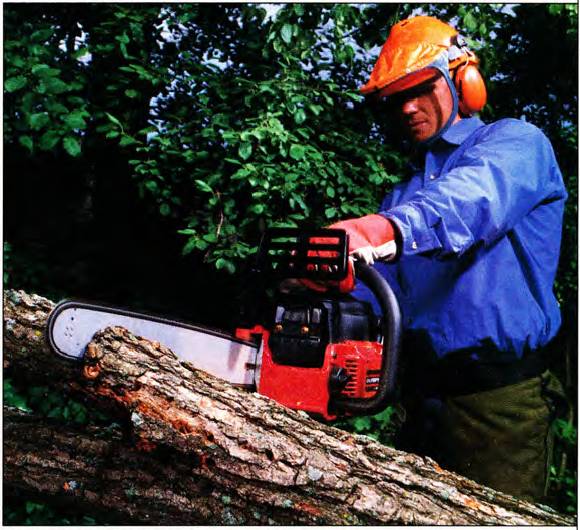
Five Chainsaw Safety Tips
- Start your saw safely by firmly gripping the handle between your knees. Keep your left elbow locked as you pull the starter rope with your right hand.
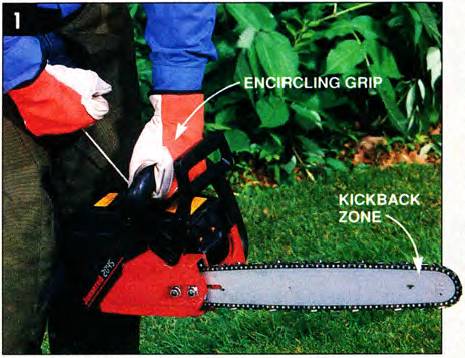
- Notch cut on the side at the trunk you want the tree to fall. Help support your saw by bracing your right wrist against your right leg. First make the steep upper cut, then an intersecting cut at 90 degrees. Cut through about 1/3 of the tree's diameter — never deeper. Remove the wedge.
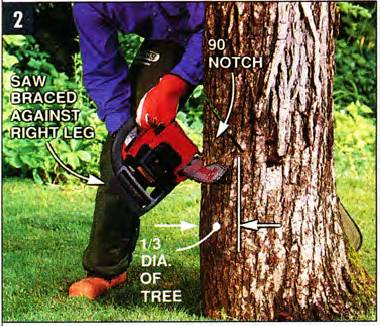
- Make the horizontal felling cut 1 in. above the corner of the wedge cut. Never cut all the way through. Leave the hinge section — it controls the direction of the tall and prevents the tree from spinning unpredictably. When the back of the cut begin: to open, turn aft the saw and move away.
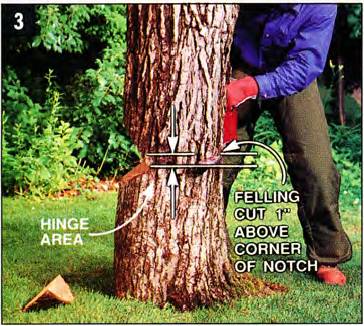
- Undercut a trunk that’s held off the ground at both ends. First make an upper relief cut 1/4 of the way through. Finish by cutting up from below.
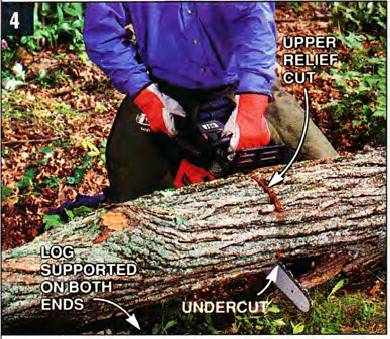
- Position yourself to the side, out of the line of kickback. Keep the left elbow locked and the let fingers in an encircling grip. Wear all recommended safety equipment.
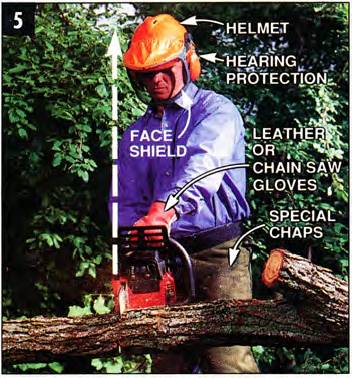
Chain saw risks
A chain saw is “king of the jungle” when it comes to cutting firewood, clearing a path or trimming landscaping timbers to length. But not everyone treats this roaring beast with due respect. Every year there are around 30,000 chain saw accidents. Some 300 people die every year, too.
Surprisingly, many of these injuries will involve not beginners, but experienced users — those who become too comfortable with their saw, then develop bad habits.
The most common injuries, those to the left thigh and hand, could be virtually eliminated if users showed common sense — remembering to grip the saw correctly and keep the bar and chain pointed away from themselves after making a cut.
The following is a quick refresher for those familiar with the basics of working with a chain saw. I hope these reminders keep you cutting safely and efficiently.
The proper saw
Chain saw manufacturers continue to improve the safety features of their saws and chains, especially on saws marketed for the homeowner.
Many safety features have been designed to minimize “kickback” — the sudden backlash caused when the upper tip of the chain saw bar and chain catches a limb or other object and propels the chain saw up and back toward the operation.
Specially designed safety chains greatly reduce kickback accidents. These chains cut only slightly slower than regular chains and cost no more: you’re a fool not to use one. Even if your saw didn‘t originally come with a safety chain, it can almost certainly be fitted with one. Anti-kickback tips that cover the bar nose, specially shaped guide bars and chain brakes (guards designed to stop the chain in the event of a kickback) also minimize accidents
Personal safety equipment
When you saw, always wear a hard hat and ear and eye protection. A special helmet with attached ear muffs and a full-face screen or shield (like the one pictured) keeps all your above-the-neck safety gear in one compact, easy-to-find package.
Buy and wear protective gloves — leather ones are adequate, but those made with cut-resistant ballistic nylon are best. Protect your legs with chain saw chaps, too; those with layers of Kevlar padding offer some of the best protection money can buy. You may cringe at the thought of spending $350 to $500 on safety equipment you may wear only a few times a year, but this investment pales in comparison to the $9,500 spent mending the average chain saw injury.
Proper chainsaw cutting technique
Approach each tree and cut as if the worst could happen — and then chances are it won’t. Remember:
- Don't operate a saw when you're tired or alone in an isolated area.
- Keep your work area clear of debris and bystanders.
- Use the correct grip as shown in Photo 1. Always keep the thumb of your left hand wrapped under the front bar, so your fingers form an encircling grip. That way your hand can't slip off the bar and into the chain. Keep the left elbow locked to fend off kickback.
- Always hold the saw off to the right side of your body. so the swing of a kickback will miss you (Photo 5).
- Never cut when another log or object on the far side of a log could contact the tip of the bar, causing it to kick back.
- Be especially careful around metal fences and posts; they can cause kickback, too.
- Never cut with the saw above shoulder height or with just one hand.
- Give your saw a thorough checkup prior to each use. Check and adjust the tension of the chain: it should move freely around the bar. but not sag.
- Make sure you’re using the correct gas/oil mix. Check and replenish your bar oil chamber every time you refuel. Use only specially formulated bar oil — it contains additives that help it cling to the chain and stand up to pressure
- Don't attempt tasks beyond your skill range. If you are uncomfortable with a situation, call a pro.
Letting the chips fly
Transforming a standing tree into firewood involves three basic steps: felling, limbing, and bucking.
Don’t even pull the starter rope until you’ve carefully examined the tree you’ll be felling and the surrounding area. Take into account wind direction, the lean of the tree, any heavy branches and the landing zone. Check for overhead obstructions and power lines. When you’re comfortable the tree will fall where you intend, make certain you have a clear escape path. A 45-deg’ree angle back and away from the line of the fall is safest. Photos 2 and 3 show the basic felling principles.
Trim off (“limb”) the small branches from the fallen tree before cutting the main branches and trunk into manageable lengths. Start limbing at the top of the tree and stand to the uphill side so cutoffs and branches tall and roll away from you.
Put your saw down and clear your path occasionally; many accidents occur when users are holding the saw in one hand and wrestling branches with the other.
In the course of “bucking” (cutting a tree into firewood lengths) you will encounter branches or tree trunks supported on both ends. You need to make both undercuts and overcuts to reduce the tension, so the wood won’t bind and entrap your saw bar. Often you will finish your cut from the underside to avoid binding (Photo 4).
Avoid dipping your chain saw into the ground. Dirt and rocks will dull a chain in a fraction of a second.
Nothing beats a chainsaw for fast, efficient cutting. But knowing the right techniques, wearing the right safety apparel, such as a face shield and ear protection, and maintaining the right saw came first. Keep reading for more details and pictures on how to safely use a chain saw.

Five Chainsaw Safety Tips
- Start your saw safely by firmly gripping the handle between your knees. Keep your left elbow locked as you pull the starter rope with your right hand.

- Notch cut on the side at the trunk you want the tree to fall. Help support your saw by bracing your right wrist against your right leg. First make the steep upper cut, then an intersecting cut at 90 degrees. Cut through about 1/3 of the tree's diameter — never deeper. Remove the wedge.

- Make the horizontal felling cut 1 in. above the corner of the wedge cut. Never cut all the way through. Leave the hinge section — it controls the direction of the tall and prevents the tree from spinning unpredictably. When the back of the cut begin: to open, turn aft the saw and move away.

- Undercut a trunk that’s held off the ground at both ends. First make an upper relief cut 1/4 of the way through. Finish by cutting up from below.

- Position yourself to the side, out of the line of kickback. Keep the left elbow locked and the let fingers in an encircling grip. Wear all recommended safety equipment.

Chain saw risks
A chain saw is “king of the jungle” when it comes to cutting firewood, clearing a path or trimming landscaping timbers to length. But not everyone treats this roaring beast with due respect. Every year there are around 30,000 chain saw accidents. Some 300 people die every year, too.
Surprisingly, many of these injuries will involve not beginners, but experienced users — those who become too comfortable with their saw, then develop bad habits.
The most common injuries, those to the left thigh and hand, could be virtually eliminated if users showed common sense — remembering to grip the saw correctly and keep the bar and chain pointed away from themselves after making a cut.
The following is a quick refresher for those familiar with the basics of working with a chain saw. I hope these reminders keep you cutting safely and efficiently.
The proper saw
Chain saw manufacturers continue to improve the safety features of their saws and chains, especially on saws marketed for the homeowner.
Many safety features have been designed to minimize “kickback” — the sudden backlash caused when the upper tip of the chain saw bar and chain catches a limb or other object and propels the chain saw up and back toward the operation.
Specially designed safety chains greatly reduce kickback accidents. These chains cut only slightly slower than regular chains and cost no more: you’re a fool not to use one. Even if your saw didn‘t originally come with a safety chain, it can almost certainly be fitted with one. Anti-kickback tips that cover the bar nose, specially shaped guide bars and chain brakes (guards designed to stop the chain in the event of a kickback) also minimize accidents
Personal safety equipment
When you saw, always wear a hard hat and ear and eye protection. A special helmet with attached ear muffs and a full-face screen or shield (like the one pictured) keeps all your above-the-neck safety gear in one compact, easy-to-find package.
Buy and wear protective gloves — leather ones are adequate, but those made with cut-resistant ballistic nylon are best. Protect your legs with chain saw chaps, too; those with layers of Kevlar padding offer some of the best protection money can buy. You may cringe at the thought of spending $350 to $500 on safety equipment you may wear only a few times a year, but this investment pales in comparison to the $9,500 spent mending the average chain saw injury.
Proper chainsaw cutting technique
Approach each tree and cut as if the worst could happen — and then chances are it won’t. Remember:
- Don't operate a saw when you're tired or alone in an isolated area.
- Keep your work area clear of debris and bystanders.
- Use the correct grip as shown in Photo 1. Always keep the thumb of your left hand wrapped under the front bar, so your fingers form an encircling grip. That way your hand can't slip off the bar and into the chain. Keep the left elbow locked to fend off kickback.
- Always hold the saw off to the right side of your body. so the swing of a kickback will miss you (Photo 5).
- Never cut when another log or object on the far side of a log could contact the tip of the bar, causing it to kick back.
- Be especially careful around metal fences and posts; they can cause kickback, too.
- Never cut with the saw above shoulder height or with just one hand.
- Give your saw a thorough checkup prior to each use. Check and adjust the tension of the chain: it should move freely around the bar. but not sag.
- Make sure you’re using the correct gas/oil mix. Check and replenish your bar oil chamber every time you refuel. Use only specially formulated bar oil — it contains additives that help it cling to the chain and stand up to pressure
- Don't attempt tasks beyond your skill range. If you are uncomfortable with a situation, call a pro.
Letting the chips fly
Transforming a standing tree into firewood involves three basic steps: felling, limbing, and bucking.
Don’t even pull the starter rope until you’ve carefully examined the tree you’ll be felling and the surrounding area. Take into account wind direction, the lean of the tree, any heavy branches and the landing zone. Check for overhead obstructions and power lines. When you’re comfortable the tree will fall where you intend, make certain you have a clear escape path. A 45-deg’ree angle back and away from the line of the fall is safest. Photos 2 and 3 show the basic felling principles.
Trim off (“limb”) the small branches from the fallen tree before cutting the main branches and trunk into manageable lengths. Start limbing at the top of the tree and stand to the uphill side so cutoffs and branches tall and roll away from you.
Put your saw down and clear your path occasionally; many accidents occur when users are holding the saw in one hand and wrestling branches with the other.
In the course of “bucking” (cutting a tree into firewood lengths) you will encounter branches or tree trunks supported on both ends. You need to make both undercuts and overcuts to reduce the tension, so the wood won’t bind and entrap your saw bar. Often you will finish your cut from the underside to avoid binding (Photo 4).
Avoid dipping your chain saw into the ground. Dirt and rocks will dull a chain in a fraction of a second.
